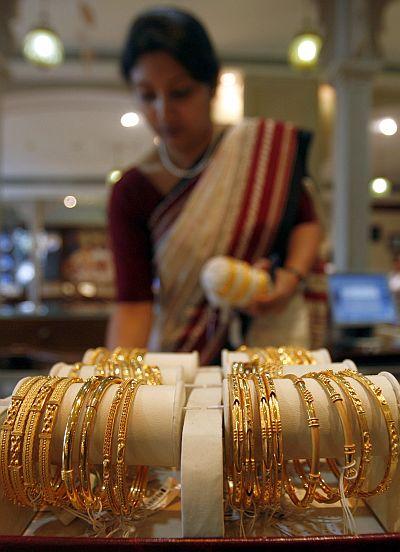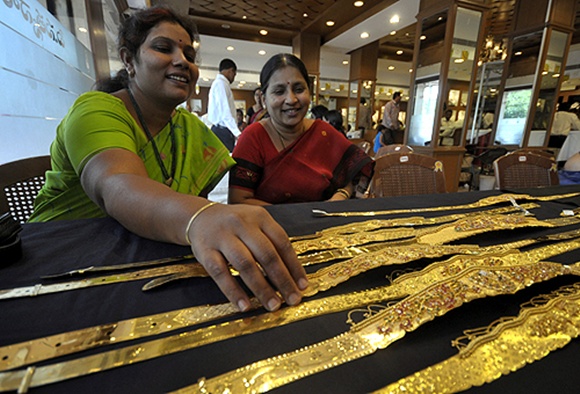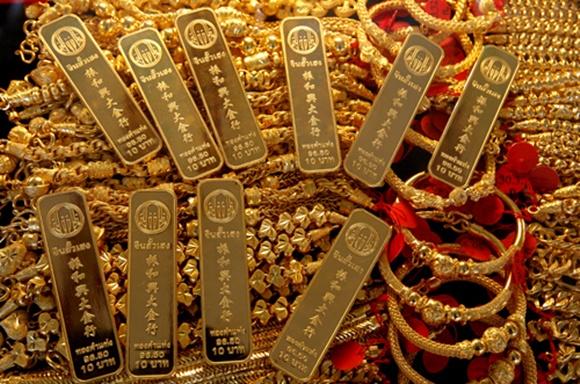Photographs: Jayanta Shaw/Reuters Sachin P Mampatta
Gold exchange traded funds (ETFs) have a new element of risk.
These schemes which earlier held physical gold equivalent to the unit holders’ investments, now lend a portion of these, as part of a government move to meet gold demand through domestic sources.
This means they no longer directly hold all the gold their investors have paid for. This introduces an element of credit risk to these funds, say experts.
...
New gold ETF norms may make investment risky
Image: Under the new directive, investors can no longer directly hold all the gold they have paid for.Photographs: Reuters
Goldman Sachs Asset Management runs India’s largest gold ETF. It issued a note to investors last month that the risk profile of the product had changed.
“A situation could arise where the issuer is unable to return the principal physical gold to GS Gold BeES (their scheme) upon maturity or in case of an early redemption.
Such inability to return physical gold could arise on account of liquidity problems or general financial health of the issuer,” said the note.
...
New gold ETF norms may make investment risky
Image: Indian gold ETFs continue to be more conservative than their global counterparts, according to experts.Photographs: Reuters
This, in turn, poses a risk to unit holders in the mutual fund scheme. “GDS (gold deposit scheme), being an unlisted and non-transferrable security, can be redeemed only with the issuer and, hence, is subject to the risk of an issuer’s inability to meet principal and interest payments on the obligation (credit risk),” it added.
...
New gold ETF norms may make investment risky
Image: The government has tweaked norms for gold ETF.Photographs: Reuters
Dhirendra Kumar, chief executive officer of fund tracker, Value Research, said the nature of the gold ETF had changed.
“So far, the situation was that the underlying (product) was gold, and now the gold is lent to someone else."
He furhter said, The lending norms are stringent but, still, the moment you lend, how the gold will circulate and the process of replenishing the stock as required adds some complexity to the fund,” he said.
...
New gold ETF norms may make investment risky
Image: The new directive on gold ETF investment may not have immediate impact on investors, say experts.Photographs: Reuters
Niranjan Risbood, director, fund research, Morningstar India, said the risk was minimal in a benign market but could be magnified in extreme situations.
“I don’t think it will have a significant impact in terms of risk, especially since the institutions they are lending to include entities such as the largest bank in India."
He further said, "It is only in extreme cases of liquidity crises, where investors are rushing to redeem in large numbers, that there would be a risk,” he said.
...
New gold ETF norms may make investment risky
Image: International ETFs offer the option of investing in gold derivative contracts, as well as take leveraged positions on gold.Photographs: Reuters
 Indian gold ETFs continue to be more conservative than their global counterparts, according to Risbood.
Indian gold ETFs continue to be more conservative than their global counterparts, according to Risbood.
International ETFs offer the option of investing in gold derivative contracts, as well as take leveraged positions on gold, he noted.
Indian gold ETFs can invest up to 20 per cent of their assets in gold deposit schemes, according to the Sebi circular on the matter.
However, they invest a lower proportion in such schemes, shows the data.
...
New gold ETF norms may make investment risky
Image: Indian gold ETFs can invest up to 20 per cent of their assets in gold deposit schemes, according to the Sebi circular on the matter.Photographs: Reuters
For example, consider the Goldman Sachs Gold ETF Fund, and the R*Shares Gold ETF. These manage a little more than 50 per cent of these assets.
They had invested 4.6 per cent and 1.4 per cent of their assets in gold deposit schemes, respectively; according to May-end figures available on the websites of the two asset managers.
There are currently 13 gold ETFs in existence, with total assets under management of Rs 9,039 crore (Rs 90.39 billion), according to June figures from Value Research.









article